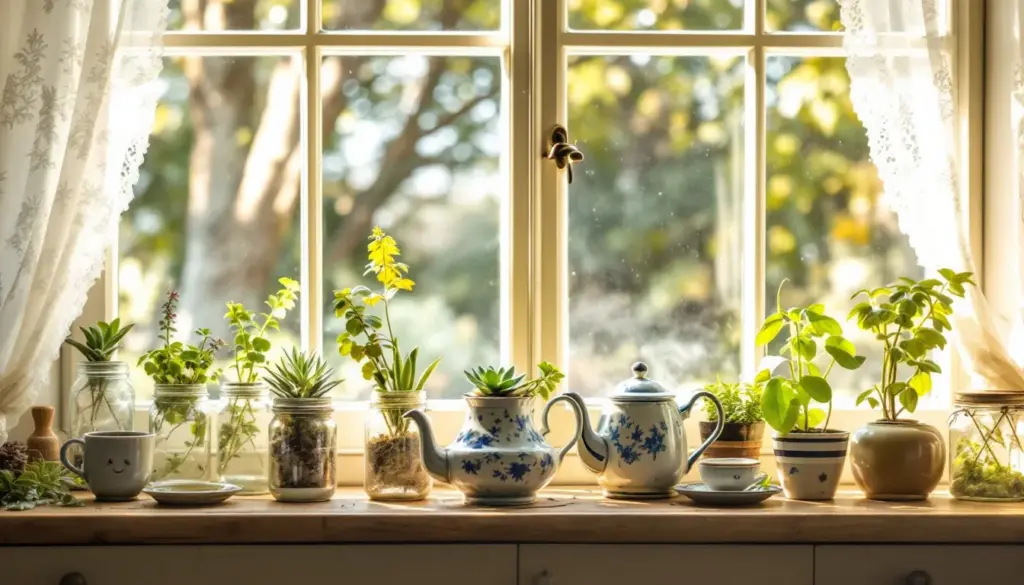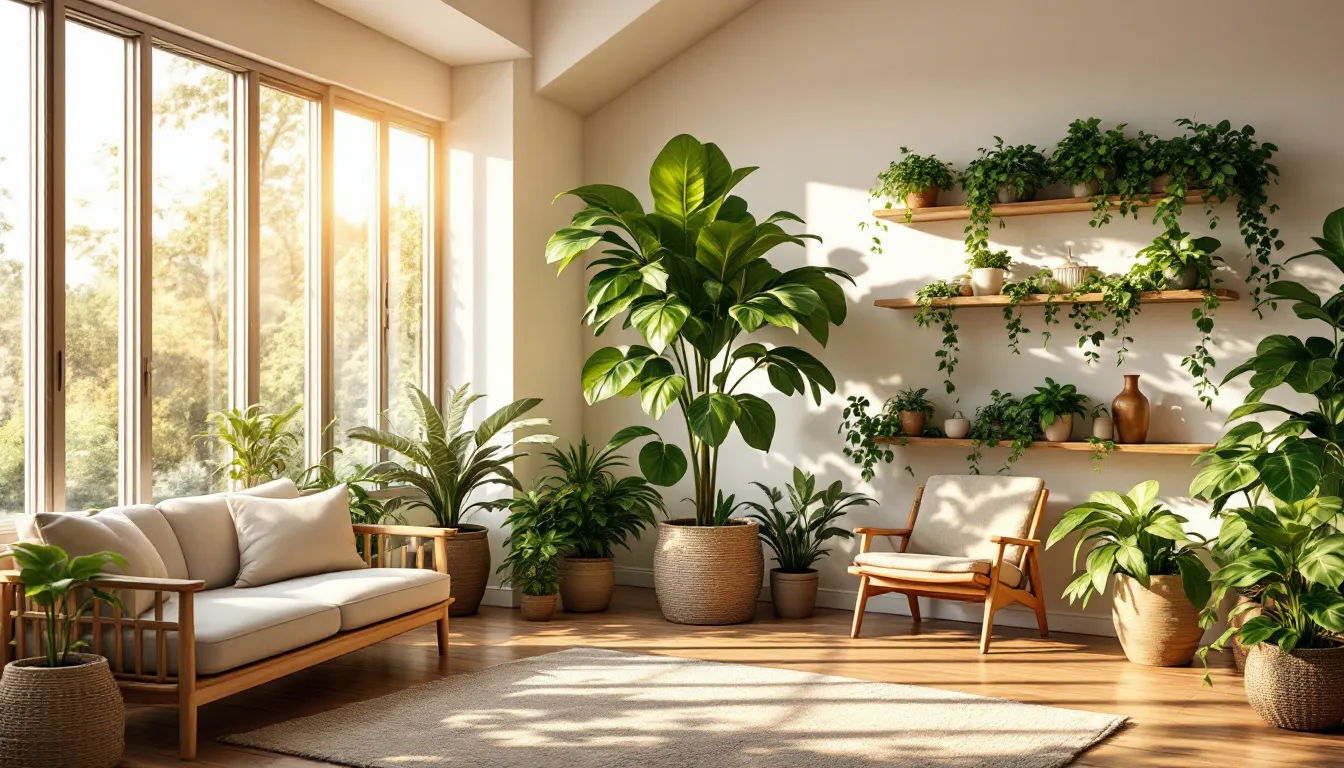Bringing plants into your home isn’t just about adding a touch of green; it’s about creating a space that feels alive, balanced, and connected to nature. Indoor plants can transform your interiors, offering benefits like improved air quality, a sense of calm, and a fresh aesthetic.
Whether you’re working with a tight budget or have room to splurge, there are creative ways to incorporate plants that suit your style and space.
From low-maintenance species to clever use of vertical spaces, you can design a lush, inviting environment without breaking the bank.
Mixing live plants with faux elements or repurposing materials can add depth and sustainability to your design. It’s all about blending nature and architecture to craft a home that feels like a thriving, green sanctuary.
How To Work With Plants In Interior Home Design
Incorporating plants into your home design creates a vibrant, calming atmosphere while blending nature with architecture. By focusing on placement, room dynamics, and visual flow, you can transform any space into a lush, inviting sanctuary.
Sensing Out Your Space And The Right Placements
Start by assessing your space to determine where plants fit naturally. Consider areas with natural light, like near windows or under skylights, for species that thrive in sunlight.
Use vertical spaces, such as shelves or hanging planters, to maximize greenery without cluttering the floor.
For darker corners, opt for low-maintenance plants like snake plants or pothos.
Room Dynamics
Each room has unique conditions that influence plant placement.
Kitchens benefit from herbs like basil or mint, which are both functional and decorative. Bedrooms pair well with air-purifying plants like peace lilies or spider plants to enhance relaxation.
In living rooms, larger plants like fiddle-leaf figs or monstera create a focal point.
Focal Points and Visual Flow
Plants guide the eye and create balance in a room.
Group plants of varying heights and textures to create visual interest. Use trailing plants like ivy or philodendron to draw attention to specific areas, such as a reading nook or fireplace.
Place taller plants in corners to add height and depth, while smaller plants on tables or shelves soften edges.

Low-Maintenance and Adaptive Species
Choosing the right plants for your home ensures they thrive with minimal effort while enhancing your space. Focus on hardy varieties and pet-safe options to create a harmonious environment.
Hardy Indoor Varieties
ZZ Plants and Snake Plants are ideal for beginners, requiring little water and thriving in low light.
These species are perfect for busy homeowners who want greenery without constant upkeep.
Spider Plants and Peace Lilies adapt well to humidity changes and improve air quality by filtering toxins like formaldehyde.
Pet-Friendly and Non-Toxic Options
For homes with pets, Peperomia and Boston Ferns are excellent choices. They’re non-toxic and safe for curious animals, unlike Philodendrons, which can be harmful.
These plants combine vibrant aesthetics with practicality, ensuring your space stays stylish and pet-friendly.
Creative and Budget-Friendly Planters
Adding plants to your home doesn’t have to break the bank. With a little creativity, you can transform everyday items into unique planters that enhance your space while staying budget-conscious.
Upcycled Containers
Repurpose items like teapots, mason jars, or vintage mugs to create charming planters for small succulents or air plants.
Thrifted baskets or painted ceramic pots can also disguise plastic nursery containers, blending functionality with rustic charm.
These upcycled containers add whimsy to kitchens or shelves while keeping costs low.
Eco-Friendly Materials
Opt for sustainable materials like jute or cotton planters, which provide breathability and align with eco-friendly design trends. These materials not only support healthier plant growth but also contribute to a more sustainable home environment.
Pair them with low-maintenance plants for a stylish, earth-conscious touch.
Vertical Gardening
Vertical gardening transforms compact spaces into lush, green sanctuaries. By utilizing walls, ceilings, and tiered structures, you can maximize space while adding depth and texture to your interiors.
Hanging Installations and Living Walls
Macramé hangers and wall-mounted frames are perfect for showcasing trailing plants like Devil’s Ivy or String of Pearls. These installations create cascading greenery without taking up floor space.
For a functional yet decorative touch, try DIY vertical gardens using repurposed pallets or fabric pockets. They’re ideal for growing herbs in kitchens while blending utility with style.
Tiered Displays and Shelving
Multi-tiered plant stands and floating shelves let you group plants at varying heights, adding visual depth to your space.
This approach not only maximizes vertical space but also creates a dynamic, textured display that draws the eye upward.
Arrange succulents, ferns, and pothos in staggered layers to mimic natural ecosystems.
Mixing Live and Faux Flora
Combining live and artificial plants creates a dynamic, low-maintenance indoor garden. This approach ensures year-round vibrancy while offering flexibility in design.
Seamless Blending Techniques
Pair high-quality faux plants like Fiddle-Leaf Figs or Fern sprays with real moss or dried branches for a natural look. This combination balances aesthetics and practicality, especially in low-light areas where live plants struggle.
Seasonal and Thematic Accents
Switch up your plant decor with seasonal touches. Use Anthuriums for spring, Norfolk Pines for winter, and faux berries for festive variety.
These accents keep your space fresh and aligned with the changing seasons.

Propagate Your Own Plants To Save Money
Growing your own plants from cuttings is a cost-effective way to expand your indoor garden while adding a personal touch to your space.
Sharing Clones
Propagating plants like Spider Plants, Pothos, and Succulents is simple and rewarding.
Place cuttings in water-filled glass jars or layered terrariums to watch roots develop, turning propagation into a decorative feature. This method lets you grow new plants without spending extra money, making it perfect for budget-conscious homeowners.
Community Plant Swaps
Joining local plant exchanges or online groups gives you access to rare species like Monstera or Rubber Plants without any cost.
It’s a fun, sustainable way to refresh your decor while connecting with fellow plant enthusiasts.
Swapping cuttings with others diversifies your collection and builds a sense of community.
Foliage Plants: Both Beautiful & Functional
Foliage plants bring beauty and practicality to your home, enhancing aesthetics while serving functional purposes. From improving air quality to masking design flaws, they’re versatile additions to any space.
Control Humidity And Freshen The Air
Peace Lilies and Boston Ferns are excellent choices for improving indoor air quality.
This dual benefit creates a healthier, more comfortable environment, especially in dry or poorly ventilated spaces.
They filter toxins like formaldehyde and benzene while naturally increasing humidity levels.
Hide Your (Design) Flaws
Large plants like Ficus Lyrata draw attention away from architectural imperfections, such as uneven walls or awkward corners.
These plants not only beautify your space but also solve common design challenges effortlessly.
Hanging Ivy is perfect for concealing outdated fixtures or adding a touch of greenery to overlooked areas.
Living Style That Feels Luxurious
Transform your home into a luxurious retreat by blending nature with thoughtful design. Plants elevate your space, adding elegance and a sense of calm without breaking the bank.
Blending Furniture And Foliage
Pair plants with furniture to enhance your decor style. Use Snake Plants in brass planters for mid-century modern vibes or Jade Plants in terracotta pots for a rustic touch.
These combinations create harmony between your furnishings and greenery, making your space feel cohesive and intentional.
Lighting For Dramatic Effects
Position plants in natural light to highlight their beauty and ensure they thrive.
Sunlit corners become focal points, with leaves casting soft shadows that add depth and drama. This approach not only boosts plant health but also enhances the overall ambiance of your room.
Synthesizing Nature and Design
Bringing plants into your home isn’t just about adding greenery, it’s about creating a space that feels alive and harmonious. By thoughtfully blending nature with your interior design, you can transform your home into a sanctuary that’s both beautiful and functional.
Whether you’re working with a small apartment or a spacious house there’s always room to experiment with plants. From vertical gardens to budget-friendly DIY planters the endless possibilities.
And with low-maintenance options and creative pairings you can enjoy the benefits of nature without the stress.
So go ahead and let your space bloom. With a little creativity and care you’ll find that plants can truly elevate your home making it a place where design and nature thrive together.

